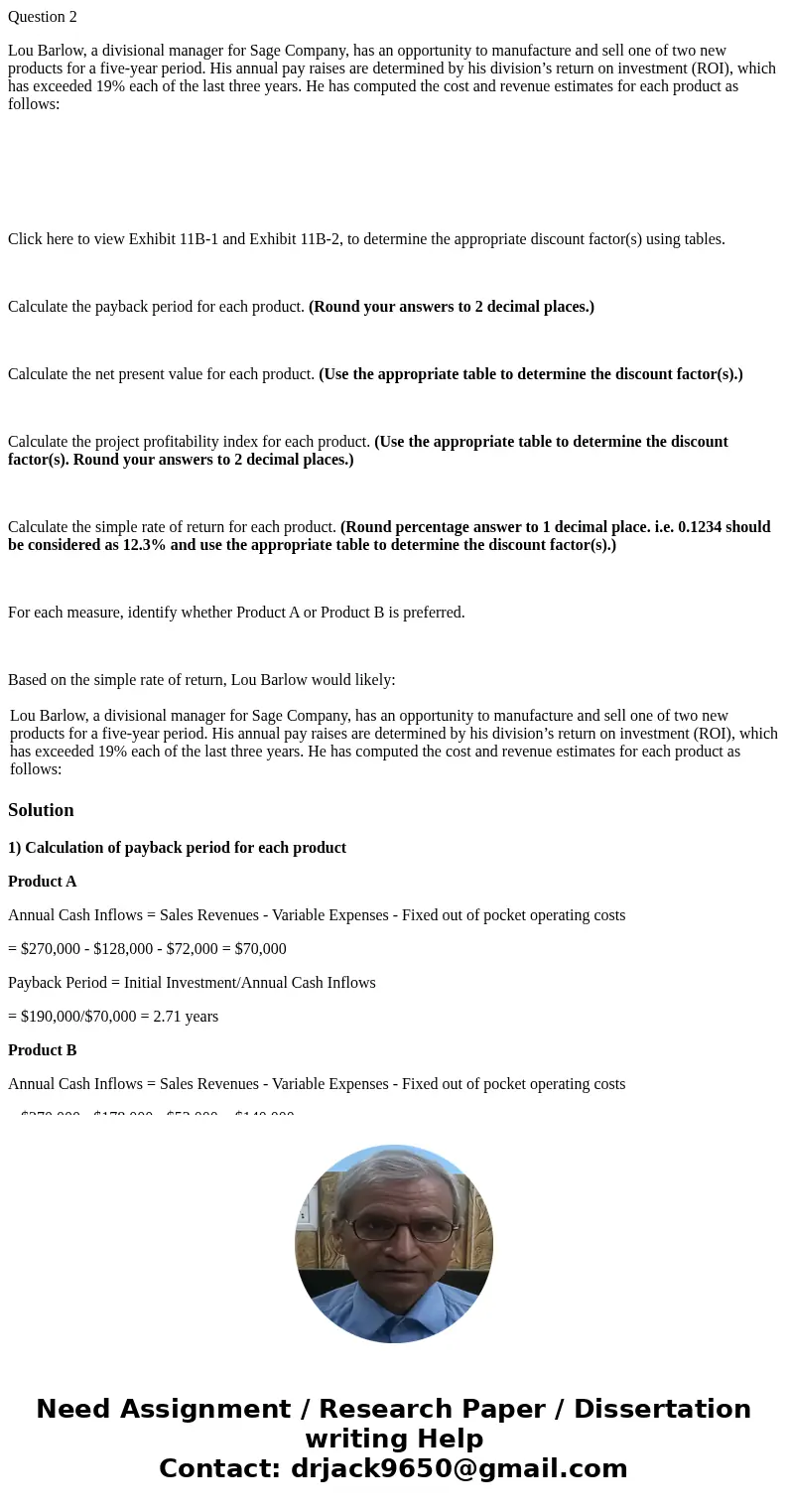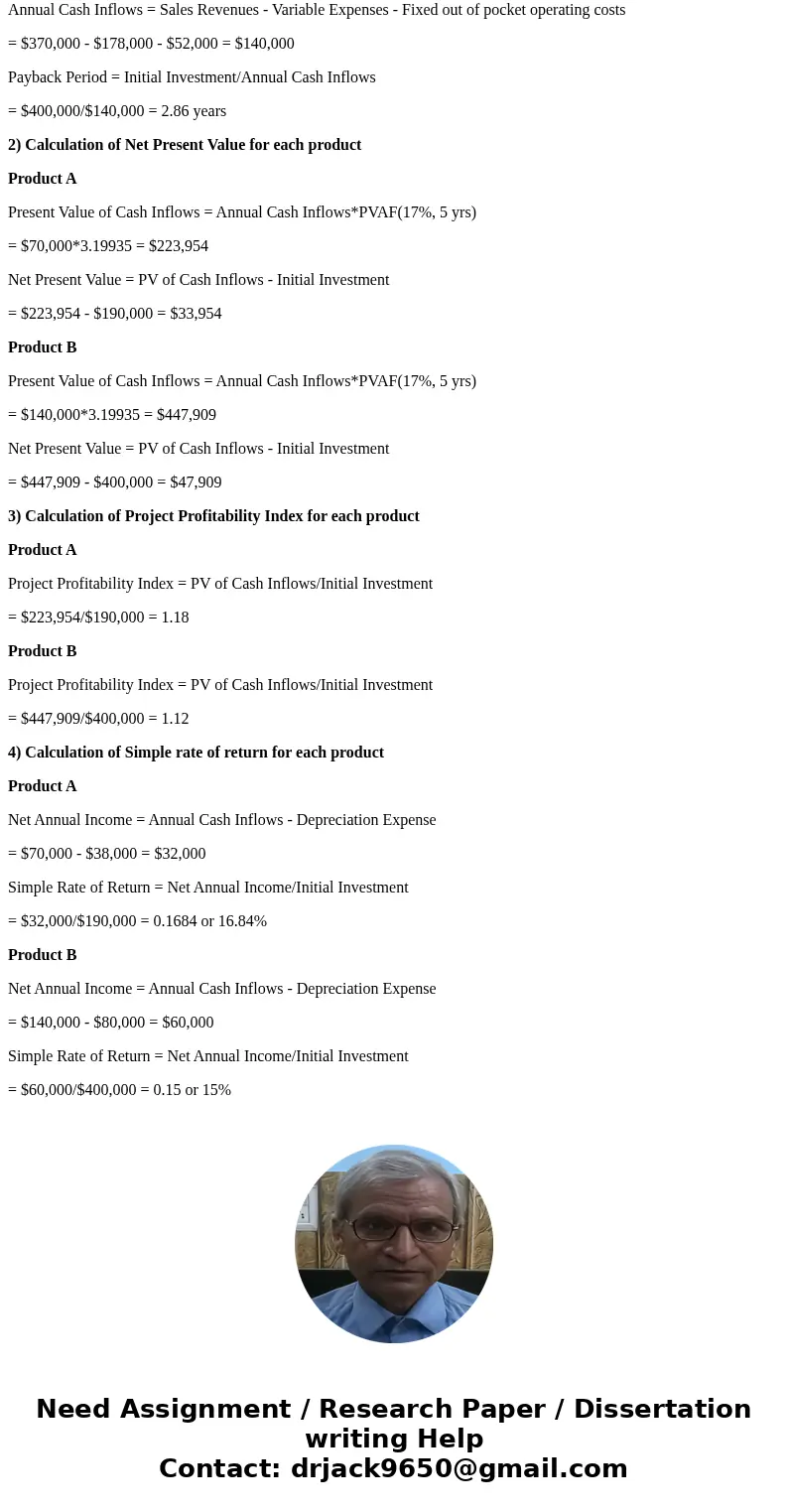Question 2 Lou Barlow a divisional manager for Sage Company
Question 2
Lou Barlow, a divisional manager for Sage Company, has an opportunity to manufacture and sell one of two new products for a five-year period. His annual pay raises are determined by his division’s return on investment (ROI), which has exceeded 19% each of the last three years. He has computed the cost and revenue estimates for each product as follows:
Click here to view Exhibit 11B-1 and Exhibit 11B-2, to determine the appropriate discount factor(s) using tables.
Calculate the payback period for each product. (Round your answers to 2 decimal places.)
Calculate the net present value for each product. (Use the appropriate table to determine the discount factor(s).)
Calculate the project profitability index for each product. (Use the appropriate table to determine the discount factor(s). Round your answers to 2 decimal places.)
Calculate the simple rate of return for each product. (Round percentage answer to 1 decimal place. i.e. 0.1234 should be considered as 12.3% and use the appropriate table to determine the discount factor(s).)
For each measure, identify whether Product A or Product B is preferred.
Based on the simple rate of return, Lou Barlow would likely:
| Lou Barlow, a divisional manager for Sage Company, has an opportunity to manufacture and sell one of two new products for a five-year period. His annual pay raises are determined by his division’s return on investment (ROI), which has exceeded 19% each of the last three years. He has computed the cost and revenue estimates for each product as follows: |
Solution
1) Calculation of payback period for each product
Product A
Annual Cash Inflows = Sales Revenues - Variable Expenses - Fixed out of pocket operating costs
= $270,000 - $128,000 - $72,000 = $70,000
Payback Period = Initial Investment/Annual Cash Inflows
= $190,000/$70,000 = 2.71 years
Product B
Annual Cash Inflows = Sales Revenues - Variable Expenses - Fixed out of pocket operating costs
= $370,000 - $178,000 - $52,000 = $140,000
Payback Period = Initial Investment/Annual Cash Inflows
= $400,000/$140,000 = 2.86 years
2) Calculation of Net Present Value for each product
Product A
Present Value of Cash Inflows = Annual Cash Inflows*PVAF(17%, 5 yrs)
= $70,000*3.19935 = $223,954
Net Present Value = PV of Cash Inflows - Initial Investment
= $223,954 - $190,000 = $33,954
Product B
Present Value of Cash Inflows = Annual Cash Inflows*PVAF(17%, 5 yrs)
= $140,000*3.19935 = $447,909
Net Present Value = PV of Cash Inflows - Initial Investment
= $447,909 - $400,000 = $47,909
3) Calculation of Project Profitability Index for each product
Product A
Project Profitability Index = PV of Cash Inflows/Initial Investment
= $223,954/$190,000 = 1.18
Product B
Project Profitability Index = PV of Cash Inflows/Initial Investment
= $447,909/$400,000 = 1.12
4) Calculation of Simple rate of return for each product
Product A
Net Annual Income = Annual Cash Inflows - Depreciation Expense
= $70,000 - $38,000 = $32,000
Simple Rate of Return = Net Annual Income/Initial Investment
= $32,000/$190,000 = 0.1684 or 16.84%
Product B
Net Annual Income = Annual Cash Inflows - Depreciation Expense
= $140,000 - $80,000 = $60,000
Simple Rate of Return = Net Annual Income/Initial Investment
= $60,000/$400,000 = 0.15 or 15%


 Homework Sourse
Homework Sourse